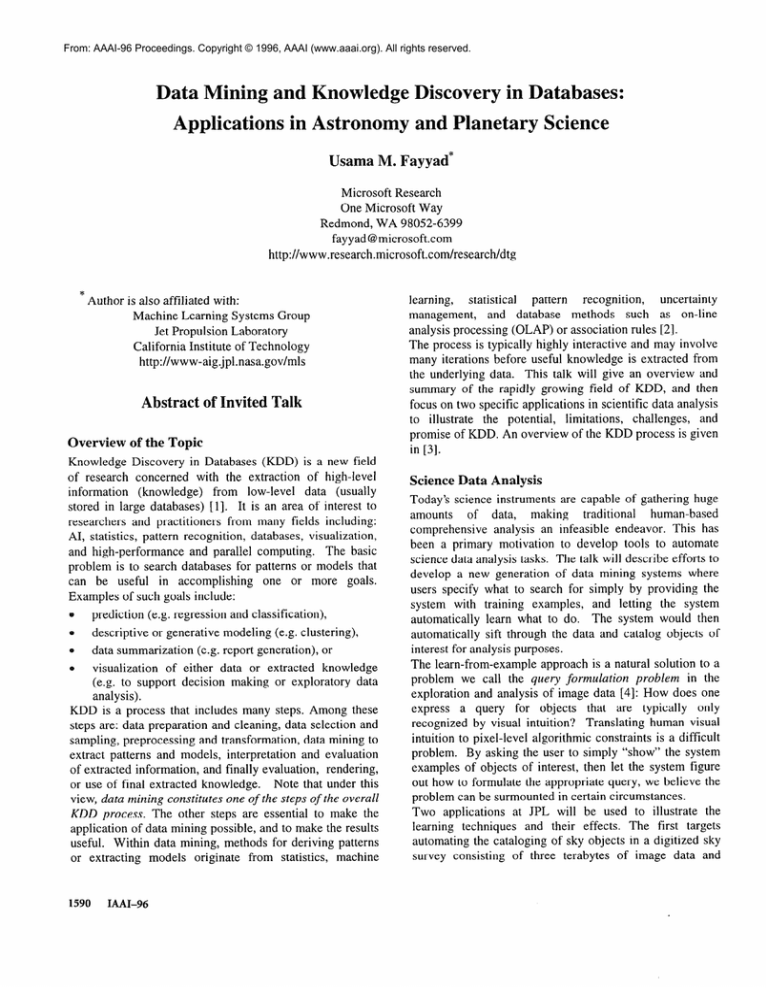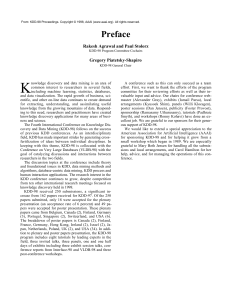
From: AAAI-96 Proceedings. Copyright © 1996, AAAI (www.aaai.org). All rights reserved.
Data Mining and Knowledge
Applications
in Astronomy
Discovery
in Databases:
and Planetary
Science
Usama M. Fayyad*
Microsoft Research
One Microsoft Way
Redmond, WA 98052-6399
fayyad @microsoft.com
http://www.research.microsoft.com/research/dtg
learning,
statistical
pattern
recognition,
uncertainty
management,
and database
methods
such as on-line
analysis processing (OLAP) or association rules [2].
The process is typically highly interactive and may involve
many iterations before useful knowledge is extracted from
the underlying data. This talk will give an overview and
summary of the rapidly growing field of KDD, and then
focus on two specific applications in scientific data analysis
to illustrate the potential,
limitations,
challenges,
and
promise of KDD. An overview of the KDD process is given
in [3].
* Author is also affiliated with:
Machine Learning Systems Group
Jet Propulsion Laboratory
California Institute of Technology
http://www-aig.jpl.nasa.gov/mls
Abstract of Invited Talk
Overview
of the Topic
Knowledge Discovery in Databases (KDD) is a new field
of research concerned with the extraction of high-level
information
(knowledge)
from low-level
data (usually
stored in large databases) [l]. It is an area of interest to
researchers and practitioners from many fields including:
AI, statistics, pattern recognition, databases, visualization,
and high-performance
and parallel computing.
The basic
problem is to search databases for patterns or models that
can be useful in accomplishing
one or more goals.
Examples of such goals include:
e
prediction
(e.g. regression
descriptive
or generative
data summarization
e
and classification),
modeling
(e.g. clustering),
(e.g. report generation),
or
visualization
of either data or extracted knowledge
(e.g. to support decision making or exploratory data
analysis).
KDD is a process that includes many steps. Among these
steps are: data preparation and cleaning, data selection and
sampling, preprocessing and transformation, data mining to
extract patterns and models, interpretation and evaluation
of extracted information, and finally evaluation, rendering,
or use of final extracted knowledge.
Note that under this
view, data mining constitutes one of the steps of the overall
KDD process. The other steps are essential to make the
application of data mining possible, and to make the results
useful. Within data mining, methods for deriving patterns
or extracting models originate from statistics, machine
1590
IAAI-96
Today’s science instruments are capable of gathering huge
amounts
of data,
making
traditional
human-based
comprehensive
analysis an infeasible endeavor. This has
been a primary motivation to develop tools to automate
science data analysis tasks. The talk will describe efforts to
develop a new generation of data mining systems where
users specify what to search for simply by providing the
system with training examples, and letting the system
automatically learn what to do. The system would then
automatically sift through the data and catalog objects of
interest for analysis purposes.
The learn-from-example
approach is a natural solution to a
problem we call the query formulation
problem in the
exploration and analysis of image data [4]: How does one
only
express a query for objects that are typically
recognized by visual intuition?
Translating human visual
intuition to pixel-level algorithmic constraints is a difficult
problem. By asking the user to simply “show” the system
examples of objects of interest, then let the system figure
out how to formulate the appropriate query, we believe the
problem can be surmounted in certain circumstances.
Two applications
at JPL will be used to illustrate the
learning techniques and their effects. The first targets
automating the cataloging of sky objects in a digitized sky
survey consisting of three terabytes of image data and
containing on the order of two billion sky objects. The Sky
Image Cataloging and Analysis Tool (SKICAT) [5] allows
for automated and accurate classification,
enabling the
automated cataloging
of an estimated two billion sky
objects, the majority of which being too faint for visual
recognition by astronomers.
This represents an instance
where learning algorithms solved a significant and difficult
scientific
analysis
problem.
Several
new results
in
astronomy have been achieved based on the SKICAT
catalog [6]. Recent results of the application of SKICAT to
help in discovery of new objects in the Universe include the
discovery of 16 new high-redshift quasars: some of the
furthest
and
oldest
objects
detectable
by today’s
instruments [7].
The second system we describe is called JARtool (JPL
Adaptive Recognition Tool) [8]. JARtool is being initially
developed to detect and catalog an estimated one million
small volcanoes (< 15km in diameter) visible in a database
consisting of over 30,000 images of the planet Venus. The
images were collected by the Magellan spacecraft using
synthetic aperture radar (SAR) to penetrate the permanent
gaseous cloud cover that obscures the planet’s surface in
the optical range.
Work at JPL’s Machine Learning Systems Group continues
to extend data mining techniques to automate analysis in
other areas of science including: cataloging of Sun spots,
remote-sensing
detection of earthquake faults [9], spatiotemporal analysis of atmospheric data, and others (see
http://www-aig.jpl.nasa.gov/mls/
for live descriptions
of
ongoing work).
Other Applications
Although this talks focuses on applications in science data
analysis, we believe these techniques to be applicable to a
wide range of problems and have little to do with the fact
that the data happens to be images. Potential applications
include
medical
imaging,
automated
inspection
and
diagnosis
in manufacturing,
decision support systems,
database marketing,
and summarization/visualization
of
Coverage of applications in science data
large databases.
in [lo].
Coverage
of industrial
analysis
is given
applications of KDD is provided in [ 111.
set). Most of these are likely to be due to spurious
correlations and random chance (simply because the data is
finite, and computation is limited). See [ 121 for a critique
and warnings of pitfalls. Hence, any derived predictions
and any inference of causality information from data is to
be taken with a fairly huge helping of salt. Furthermore,
effective techniques for incorporating the necessary prior
knowledge
about an application
into a data mining
algorithm to help the automated system avoid some of the
basic traps are still lacking.
The fact that initial successes exist should be taken as
encouraging signs that this new and emerging field holds
some promise to address the daunting
problems
of
information overload facing modern society.
nformation Resources
A good starting point to get a summary of what has been
done in this field is to start with [ l] and [ 131. Appendix 1
of [ 11 by Kloesgen and Zytkow provides a glossary of
terminology used in KDD, while Appendix 2 by PiatetskyShapiro provides pointers to various resources.
The next
source of information is to follow up on the following
resources on the internet and the world-wide web:
a
http://www-aig.jpl.nasa.gov/kdd95/
is the homepage of
the First International
Conference
on Knowledge
Discovery and Data Mining (KDD-95); The homepage
of KDD-96 is at http://www-aig.jpl.nasa.gov/kdd96.
Information on the new journal for this field: Data
Mining and Knowledge Discovery can be obtained at
http://www.research.microsoft.com/research/datamine.
@ http://info.gte.com/-kdd/
is the Knowledge Discovery
Mine maintained by Gregory Piatetsky-Shapiro
at GTE
Laboratories. This site serves as a collecting point of
information directly relevant to KDD, including tools
available free on-line, commercial products, pointers to
many other relevant groups and organizations, as well
as a repository of all back issues of KDD Nuggets.
tB KDD Nuggets: is a moderated mailing list that serves
as the main forum of communicating
with or receiving
news of interest to the KDD community
(kddrequest@gte.com).
Acknowledgments
Beware the Hype
While it is true that in many situations some simple data
mining work can result in great successes, this by no means
justifies the public perception that data mining can be used
to solve all analysis problems. The fundamental problems
in the field are far from being solved. The basic problem in
KDD is one of statistical inference from a finite set of data.
Issues of model overfitting and justification
of findings
Many models are extractable
remain as major challenges.
from data (in fact infinitely many models from a finite data
The applications
described in this talk were conducted
while the author was still with the Jet Propulsion
Laboratory, California Institute of Technology,
under a
contract
with the National
Aeronautics
and Space
Administration.
Collaborators on the SKICAT work at Caltech and Palomar
Observatory
include S.G. Djorgovski and Nick Weir. We
also thank Reinaldo DeCarvalho
and Julia Kennefick
(Caltech), Joe Roden, John Loch, Maureen Burl, Scott
Burleigh, Jennifer Yu, and Alex Gray ( JPL).
Invited Talks
1591
JARtool work is in collaboration
with Padhraic Smyth
(JPL), Michael Burl and Pietro Perona (Caltech), and Jayne
Aubele and Larry Crumpler (Brown University).
We also
thank Maureen Burl, Joe Roden, Victoria Gor, and Michael
Turmon (JPL).
Program management of this work at NASA was under the
direction of Melvin Montemerlo (Code XS), and at JPL
under direction of David Atkinson and Richard Doyle.
In my overview coverage of data mining and KDD, I have
borrowed material from my co-authors on [3]: Gregory
Piatetsky-Shapiro
and Padhraic Smyth.
References
[l]
[2]
[3]
[4]
[5]
[6]
[7]
[8]
1592
Fayyad U.; Piatetsky-Shapiro,
G.; Smyth, P.; and
Uthurusamy, R. (Eds.) 1996. Advances in Knowledge
Discovery and Data Mining. Cambridge, Mass.: MIT
Press/AAAI Press.
Agrawal, A.; Mannila, H.; Srikant, R.; Toivonen, H.;
and Verkamo, I. 1996. “Fast Discovery of Association
Rules”, in Advances in Knowledge Discovery and
Data Mining.
Fayyad
U.; Piatetsky-Shapiro,
G.;
Smyth, P.; and Uthurusamy, R. (Eds.),
Cambridge,
Mass.: MIT Press/AAAI Press.
Fayyad U.; Piatetsky-Shapiro,
G.; and Smyth, P. 1996.
“From Data Mining to Knowledge
Discovery: An
Overview”, in Advances in Knowledge Discovery and
Fayyad
U.; Piatetsky-Shapiro,
G.;
Data Mining.
Smyth, P.; and Uthurusamy, R. (Eds.),
Cambridge,
Mass.: MIT Press/AAAI Press.
Fayyad, U. and Smyth P. 1995.
“The Automated
Analysis,
Cataloging,
and Searching
of Digital
Libraries: A Machine Learning Approach”, in Digital
Libraries, Lecture Notes in Computer Science 916,
N.R. Adam, B.K. Bhargava, and Y. Yesha (Eds.)
Berlin: Springer-Verlag.
Fayyad U.; Djorgovski,
S.G.; and Weir, N. 1996.
“Automating
the Analysis and Cataloging
of Sky
Surveys”, in Advances in Knowledge Discovery and
Data Mining.
Fayyad
U.; Piatetsky-Shapiro,
G.;
Smyth, P.; and Uthurusamy, R. (Eds.),
Cambridge,
Mass.: MIT Press/AAAI Press.
Weir, N.; Djorgovski, S.G.; and Fayyad, U.M. 1995.
“Initial Galaxy Counts From Digitized
POSS-II”,
Astronomical Journal, 1 lo- 1: l-20.
Kennefick, J.D.; De Carvalho, R.R.; Djorgovski, S.G.;
Wilber, M.M.; Dickinson, E.S.; Weir, N.; Fayyad, U.;
and Roden, J. (1995). “The Discovery of Five Quasars
at z>4 using the Second Palomar Sky Survey”,
Astronomical Journal, 1 IO-1 ~78-86.
Burl, M.C.; Fayyad, U.; Perona, P.; Smyth, P.; and
Burl, M.P.
(1994).
“Automating
the Hunt for
Volcanoes on Venus”, in Proc. of Computer Vision
and Pattern Recognition Conference (CVPR-94)
pp.
302-308, IEEE Computer Society Press.
Stolorz, P. and Dean, C. 1996.
“Quakefinder:
A
Detecting
Scalable
Datamining
System
for
Earthquakes
from Space”,
submitted
to Second
International Con. on Knowledge Discovery and Data
Mining. AAAI Press.
Fayyad, U.; Haussler, D.; and Stolorz, P. 1996.
“Science Applications”, special issue on Data Mining
and Knowledge Discovery,
Communications
of the
ACM, forthcoming.
Brachman. R.J.; Khabaza, T.; Kloesgen, W.; PiatetskyShapiro, G.; and Simoudis, E. 1996.
“Industrial
Applications
of Data
Mining
and
Knowledge
Discovery”,
in Proc. Of the Second International
Conference on Knowledge Discovery and Data Mining
(KDD-96), Menlo Park, Calif.: AAAI Press.
[12] Glymour, C.; Madigan, D.; Pregibon, D.; and Smyth,
P. 1996. “Statistics and Data Mining”, special issue on
Discovery,
Data
Mining
and
Knowledge
Communications of the ACM, forthcoming.
[ 131 Piatetsky-Shapiro,
G. and Frawley
W. (1991).
Knowledge Discovery in Databases. Cambridge, MA:
MIT Press.






